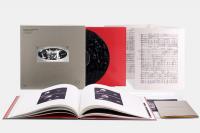The Berlin Philharmonic's Direct-to-Disc Bruckner Symphony #7 Box Set
As with the Brahms cycle conducted by Sir Simon Rattle, Emil Berliner Studios' Rainer Maillard and crew wheeled over to the Berlin Philharmonie Hall the studio's Neumann VMS-80 lathe and recorded the live performance "Direct-to-Disc", here using 3 Josephson microphones up front and a pair for the hall sound. Mic preamps were all tube-based and fed a vintage vacuum tube-based mixer running directly into the lathe. According to Mr. Mailard, The five microphone, 9 capsule array consisted of one C700S stereo-mic in the center and two C722s (custom built for EBS) left and right, plus a pair of C617 room mics. The mic preamps were Siemens V72s. The mixer was a vintage 12 channel Siemens V76.
I was honored when label manager and assistant project manager Timo Hagemeister invited me to contribute annotation for this box set. He sent a test pressing late last summer of the three-sided set (side four features signatures of all orchestra members plus Haitink's) and I set about absorbing the symphony and the recording and deciding what I should write. Was I somewhat intimidated by the task? Damn right I was! I went into this unfamiliar with Bruckner's music. I came away awed by the 7th Symphony, which, as it turns out, was his first great success after years of trying and flopping. He began composing it when he was 57.
At first, the 7th sounds as if it repeatedly grinds to a halt each time the composer gets the main theme going. Beethoven's symphonies are like rock and roll compared to Bruckner's 7th. After a few plays you can easily hum melodic elements of the 3rd, 5th, 7th and 9th (especially the 5th and 9th, which everyone knows). No wonder Beethoven is the "go-to" symphonic set for music appreciation beginner courses. It took many repeat plays to "get" Bruckner's majestic thematic thread to "set" in my head, but once it "took", it was difficult getting it out. The box set's annotation includes a musicologist's "play by play" analysis but, while helpful, the music's emotional content doesn't require that kind of understanding. The devoutly religious composer evokes awe, terror, mystery, longing, serenity and at the majestic conclusion of the first movement a sense of dazzling wonderment that feels as if you've reached, after a long climb, the top of the mountain from where you can see the heretofore hidden other side. You're left almost breathless.
From the production's description you can pretty much figure out that the recording is transparent, three-dimensional, "you are there" quality. The Berlin Philharmonie is one of the first open, non-reverberant concert hall spaces, designed (as I discovered in my annotation research) with the "modern" 60's era home stereo listener in mind. So, don't expect to experience a big reverberant space because that's not the hall sound. Instead, it's surprisingly direct and even somewhat dry, but as intended, despite the minimal miking, you hear everything all sublimely and effortlessly balanced and rendered in three-dimensional space not limited by recording tape or Pro-Tools digital sampling and processing. As I've found playing this "Rorschach Test" of a recording on various systems, if it sounds too bright, it's your system! When everything's in balance, you are in the concert hall (not in an artificially created multi-miked non-existent space, where perhaps there's more "detail" due to twenty odd microphones strewn throughout the hall). Also, the black backgrounds and unrestrained dynamics mean that if you start with the volume too high, when the big explosive sections arrive, they will be unnaturally LOUD. This recording requires some experience to correctly play back. Live concerts, especially if you're not seated "on top" of the orchestra, are never as loud as home playback, which for some first time concert hall attendees leads to disappointment. This recording, properly played back, will not disappoint! I played the first movement at RMAF to a packed PS Audio room and all in attendance sat entranced throughout.
The box set's packaging and presentation go beyond what's usually considered "above and beyond". The box itself is handsome and includes Haitink's autograph embossed on the cover. There's a large, glossy photo of the lathe in the control room high atop the hall, a copy of the program handed out to concert goers and a ticket from the performance, 4th row, center. The hard-bound book and annotation with photos will keep you busy for a while and provide historical and musical background. Optimal's plating and pressing quality are of the highest order. "Lavish" is the best single word description for the box, limited to 1884 copies (1884 was the year the symphony debuted in Leipzig on December 30th) and available now for order ($221.61 plus shipping) on the Berlin Philharmonic Recordings website. I was and remain thrilled to have been asked to play even a small part in this historic set. BTW: more than a few people have asked me why I was not at the concert. I was in Europe at the time at EISA in Antwerp, Belgium and so could not attend. After listening to this recording I almost feel as if I'd been there.
Here's the "unboxing" video:


